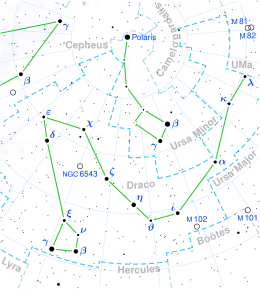Top Qs
Timeline
Chat
Perspective
Alruba
Star in the constellation Draco From Wikipedia, the free encyclopedia
Remove ads
Alruba,[10] a name derived from Arabic for "the foal", is a suspected astrometric binary[11] star system in the northern circumpolar constellation of Draco. It is just barely visible to the naked eye as a dim point of light with an apparent visual magnitude of 5.76.[3] Based on parallax measurements obtained during the Gaia mission, it is located at a distance of about 457 light-years (140 parsecs) from the Sun. The system is drifting closer with a radial velocity of −2 km/s.[6]
The visible component is an A-type main-sequence star with a stellar classification of A0 V.[5] It is about 58 million years old[8] with three times the mass of the Sun[4] and has a high rate of spin, showing a projected rotational velocity of 170 km/s.[4] The star is radiating 147 times the luminosity of the Sun[4] from its photosphere at an effective temperature of 9,226 K.[4] The system is a source for X-ray emission, which is most likely coming from the unseen companion.[12]
Remove ads
Nomenclature
In the Henry Draper catalogue this system has the designation HD 161693, while it has the identifier HR 6618 in the Bright Star Catalogue.[9]
It bore the traditional Arabic name الربع Al Rubaʽ "the foal" (specifically a young camel born in the spring), a member of the Mother Camels asterism in early Arabic astronomy.[13][14]
In 2016, the International Astronomical Union organized a Working Group on Star Names (WGSN)[15] to catalogue and standardize proper names for stars. The WGSN approved the name Alruba for this star on 1 June 2018 and it is now so entered on the List of IAU-approved Star Names.[10]
Remove ads
References
Wikiwand - on
Seamless Wikipedia browsing. On steroids.
Remove ads

